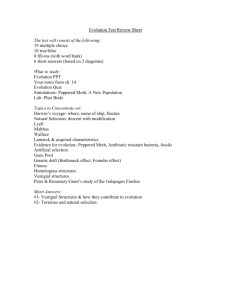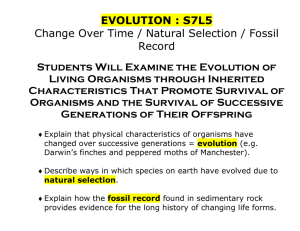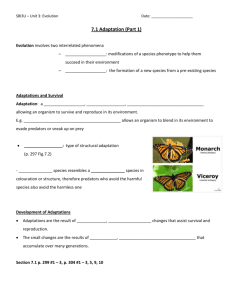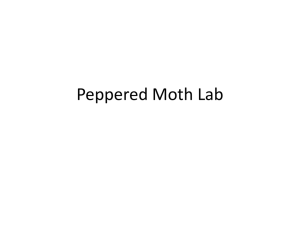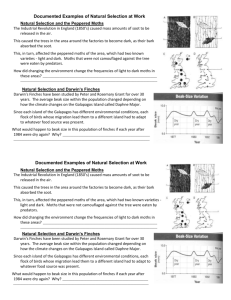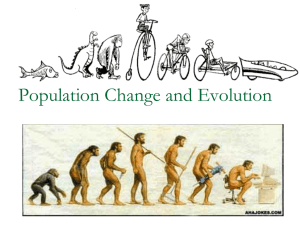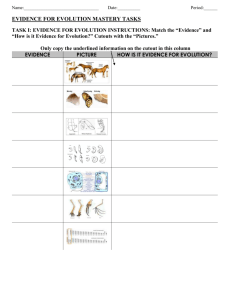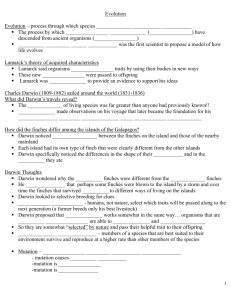Natural Selection and Peppered Moths
advertisement
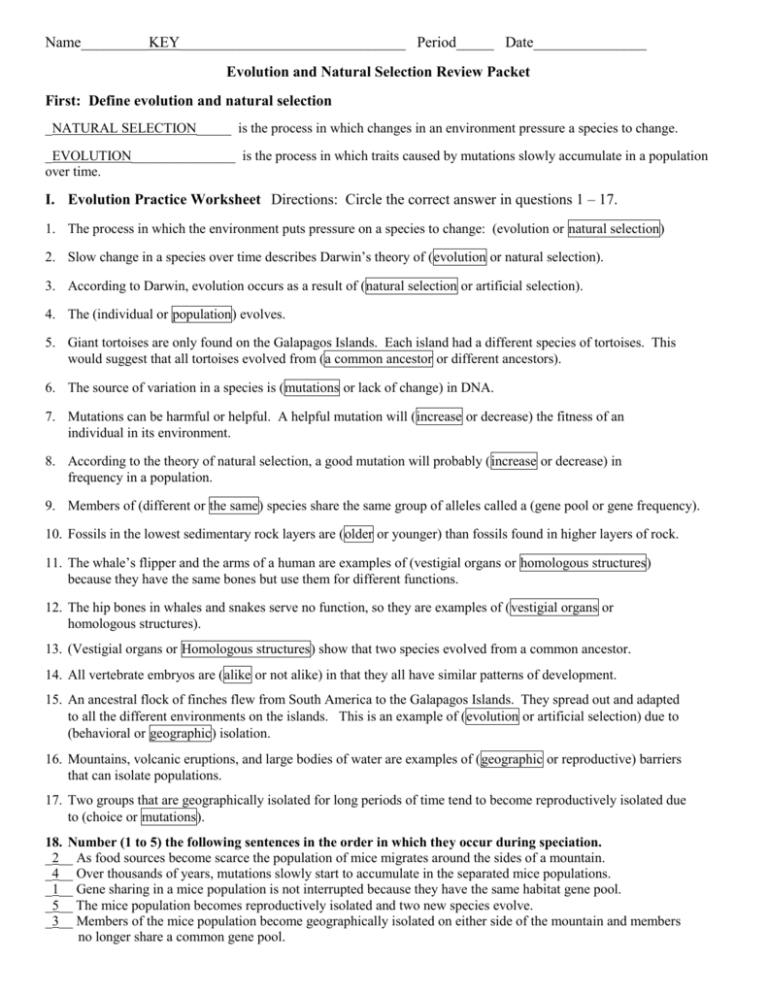
Name_________KEY______________________________ Period_____ Date_______________ Evolution and Natural Selection Review Packet First: Define evolution and natural selection _NATURAL SELECTION_____ is the process in which changes in an environment pressure a species to change. _EVOLUTION_______________ is the process in which traits caused by mutations slowly accumulate in a population over time. I. Evolution Practice Worksheet Directions: Circle the correct answer in questions 1 – 17. 1. The process in which the environment puts pressure on a species to change: (evolution or natural selection) 2. Slow change in a species over time describes Darwin’s theory of (evolution or natural selection). 3. According to Darwin, evolution occurs as a result of (natural selection or artificial selection). 4. The (individual or population) evolves. 5. Giant tortoises are only found on the Galapagos Islands. Each island had a different species of tortoises. This would suggest that all tortoises evolved from (a common ancestor or different ancestors). 6. The source of variation in a species is (mutations or lack of change) in DNA. 7. Mutations can be harmful or helpful. A helpful mutation will (increase or decrease) the fitness of an individual in its environment. 8. According to the theory of natural selection, a good mutation will probably (increase or decrease) in frequency in a population. 9. Members of (different or the same) species share the same group of alleles called a (gene pool or gene frequency). 10. Fossils in the lowest sedimentary rock layers are (older or younger) than fossils found in higher layers of rock. 11. The whale’s flipper and the arms of a human are examples of (vestigial organs or homologous structures) because they have the same bones but use them for different functions. 12. The hip bones in whales and snakes serve no function, so they are examples of (vestigial organs or homologous structures). 13. (Vestigial organs or Homologous structures) show that two species evolved from a common ancestor. 14. All vertebrate embryos are (alike or not alike) in that they all have similar patterns of development. 15. An ancestral flock of finches flew from South America to the Galapagos Islands. They spread out and adapted to all the different environments on the islands. This is an example of (evolution or artificial selection) due to (behavioral or geographic) isolation. 16. Mountains, volcanic eruptions, and large bodies of water are examples of (geographic or reproductive) barriers that can isolate populations. 17. Two groups that are geographically isolated for long periods of time tend to become reproductively isolated due to (choice or mutations). 18. Number (1 to 5) the following sentences in the order in which they occur during speciation. _2__ As food sources become scarce the population of mice migrates around the sides of a mountain. _4__ Over thousands of years, mutations slowly start to accumulate in the separated mice populations. _1__ Gene sharing in a mice population is not interrupted because they have the same habitat gene pool. _5__ The mice population becomes reproductively isolated and two new species evolve. _3__ Members of the mice population become geographically isolated on either side of the mountain and members no longer share a common gene pool. Read the following review of evidence for evolution, read the documented cases of natural selection and answer the questions about them, and then do the practice worksheet that follows. II. Evidence for Evolution. Embryology – Study of embryo development All vertebrate animals look similar to each other early in development of their embryos (embryologic development). All have gill slits and a tail (including humans), although only a few groups go on to fully develop tails and gills. It can be hypothesized that all vertebrates contain the genes that develop these structures, but in some the genes are now inactive. Homologous Structures – Similar structures in different species Similarities in homologous structures in different species are probably due to deriving from the same common ancestor. Ex: The forelimbs of various mammals. The forearms of a human, cat, dolphin, and bat are used for entirely different things (grasping, walking, swimming, flying) and yet they are composed of exactly the same bones, just arranged differently and with slight alterations. Vestigial Organs – Structures that may have been useful in the evolutionary past of the species. Ex: A hip bone for the attachment of hind legs; an appendix to digest plant material. Vestigial organs indicate an evolutionary relationship of organisms with them to organisms that still have a functioning version of the organs. Other evidence of evolution: The fossil record and DNA comparisons (comparisons of amino acid sequences). III. Documented Examples of Natural Selection at Work – Read these reviews and answer the questions after each paragraph. Natural Selection and Peppered Moths The Industrial Revolution in England in the 1850’s caused mass amounts of soot to be released into the air. This caused trees in the areas around factories to become dark as their bark absorbed the soot. This, in turn, affected the peppered moths in the area, which rested on the trees. These moths had two main varieties: light and dark. Moths that were not camouflaged against the tree trunks were eaten in greater quantities by predators, such as birds. 19. How did changing the environment in this case change the number of light versus dark peppered moths in these industrialized areas? Trees in the environment became darker because of soot, so dark peppered moths became better camouflaged on the tree trunks, light peppered moths were then eaten more frequently, more dark peppered moths survived and reproduced, and dark peppered moths became more numerous than light peppered moths. Natural Selection and Darwin’s Finches Darwin’s Finches have been studied by Peter and Rosemary Grant for over 30 years. Since each island of the Galapagos has different environmental conditions and thus somewhat different food sources, each flock of birds that moved to a different island had to adapt to whatever food source was present. On the island called Daphne Major, the average beak size within the population changed depending on how the climate changed on the island. According to data compiled by the Grants, the average beak size of the finches on Daphne Major varied in size between about 9.4 mm to about 9.8 mm depending on the amount of rainfall between 1976 and 1985. The years the average beak size was greatest, around 9.8 mm, were dry years. 1984 was a wet year, and average beak size was about 9.4 mm. 20. What would happen to beak size in this population of finches if the years after 1984 were dry again? Why? The beak sizes would increase again, because in dry years it is apparently a competitive advantage to have larger beaks, perhaps due to a decrease in the food supply in dry years and larger beaks being somehow more effective at obtaining and eating the available food. IV. Questions About Evidence of Evolution and Natural Selection at Work Natural Selection: Write the letter of the correct definition in the blank space on the left. 21. __A__ adaptation a. inherited characteristic that increases chances of survival 22. __C__ competition b. process in which organisms with traits well suited to their environment survive and reproduce at a greater rate than less welladapted organisms in the same environment 23. __B__ natural selection 24. __E__ fitness c. struggle for survival when a growing population causes a scarcity of resources 25. __D__ variation d. changes in the DNA of individuals of a population e. ability to survive and reproduce in a specific environment Evolutionary Evidence: Write the letter of the correct definition in the blank space on the left. 26. __E__ vestigial structure a. remains of dead organisms 27. __C__ homologous structures b. similarities and differences in amino acid sequences between organisms 28. __B__ DNA sequence c. structures in different organisms having the same bone makeup 29. __A__ fossil record d. study of the early development of fetuses of different organisms; has documented that in the early stages of development, dogs, pigs, and humans resemble each other 30. __D__ embryology e. structures that have reduced in size because they no longer serve an important function Fill in the blank using the terms in the box. Only six of the terms are used. variation biodiversity genotype natural selection common ancestor phenotype adaptation isolation interbreed Natural selection could not occur without (31) __VARIATION_____ and acts on a(n) (32) _GENOTYPE___. A trait that makes a species better suited to survive in its environment is called a(n) (33) _ADAPTATION_________. A species is a group of organisms that have unique features and cannot (34) _INTERBREED_________ with other organisms. All the evolutionary evidence including fossils points to organisms having a(n) (35) _COMMON ANCESTOR_______________. Having a lot of different species living in a habitat is called (36) _BIODIVERSITY_________________. What are the four principals of natural selection? Natural Selection 37. OVERPRODUCTION 38. GENETIC VARIATION 39. STRUGGLE TO SURVIVE 40. SUCCESSFUL REPRODUCTION
